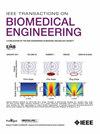脑深部刺激中神经传递激活的计算研究。
IF 4.4
2区 医学
Q2 ENGINEERING, BIOMEDICAL
引用次数: 0
摘要
深部脑刺激(DBS)是一种治疗神经退行性运动障碍(如帕金森病)的成熟疗法,它通过覆盖从中枢神经系统到运动系统的病理信号来减轻症状。几乎所有的 DBS 计算模型都直接或间接地将临床改善与刺激电极附近的纤维激活程度联系起来。然而,目前还不清楚这种激活是如何调节信息传输的。在这里,我们使用了直线或曲线轴突的精确索方程,并证明了 DBS 将信号通路分为三种交流模式之一:完全信息阻断、单向和双向传输。此外,所有这些模式都以异步但频率锁定的方式对刺激脉冲做出反应。异步性取决于轴突的几何形状、位置和方向以及刺激方案。同时,神经的电生理学决定了频率锁定。这种三态反应对将激活作为二元状态的概念以及将激活与 DBS 结果相关联的研究提出了挑战。重要的是,我们的研究表明,从机理上理解 DBS 的作用有赖于区分这三种信息传输模式。本文章由计算机程序翻译,如有差异,请以英文原文为准。
A Computational Study on the Activation of Neural Transmission in Deep Brain Stimulation
Deep brain stimulation (DBS) is an established treatment for neurodegenerative movement disorders such as Parkinson's disease that mitigates symptoms by overwriting pathological signals from the central nervous system to the motor system. Nearly all computational models of DBS, directly or indirectly, associate clinical improvements with the extent of fiber activation in the vicinity of the stimulating electrode. However, it is not clear how such activation modulates information transmission. Here, we use the exact cable equation for straight or curved axons and show that DBS segregates the signaling pathways into one of the three communicational modes: complete information blockage, uni-, and bi-directional transmission. Furthermore, all these modes respond to the stimulating pulse in an asynchronous but frequency-locked fashion. Asynchrony depends on the geometry of the axon, its placement and orientation, and the stimulation protocol. At the same time, the electrophysiology of the nerve determines frequency-locking. Such a trimodal response challenges the notion of activation as a binary state and studies that correlate it with the DBS outcome. Importantly, our work suggests that a mechanistic understanding of DBS action relies on distinguishing between these three modes of information transmission.
求助全文
通过发布文献求助,成功后即可免费获取论文全文。
去求助
来源期刊

IEEE Transactions on Biomedical Engineering
工程技术-工程:生物医学
CiteScore
9.40
自引率
4.30%
发文量
880
审稿时长
2.5 months
期刊介绍:
IEEE Transactions on Biomedical Engineering contains basic and applied papers dealing with biomedical engineering. Papers range from engineering development in methods and techniques with biomedical applications to experimental and clinical investigations with engineering contributions.
 求助内容:
求助内容: 应助结果提醒方式:
应助结果提醒方式:


